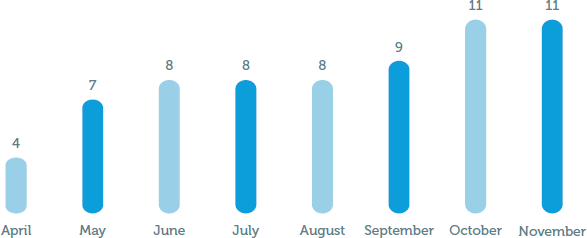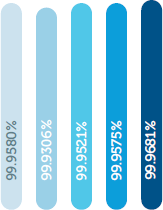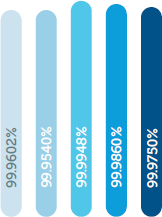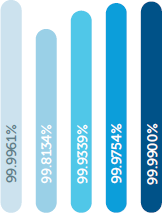Operational
Excellence
and Growth
The Company has adopted
advanced technologies to
guarantee the reliability
and
operational excellence
of its assets.
2011 Investments
Growth in total number of connection projects being executed by CTEEP Operational Performance
Introdution
GRI EU4
Expansion of CTEEP business is based on
three cornerstones:
- Expansions in its transmission system
- Participation in industry asset bids
- Acquisitions of existing assets
Bids
CTEEP actively participated in bids held by the National Electrical Energy Agency (ANEEL) in 2011 and was awarded two transmission lots in Bid 004/2011, held on September 2. When the ventures awarded are finalized, the Company will be present in 15 states in Brazil.
In a consortium formed with CHESF, CTEEP won a lot comprised of two substations (Garanhuns 500/230 kV and Pau Ferro 500/230 kV) and four power lines located in Paraíba, Pernambuco and Alagoas: Luiz Gonzaga-Garanhuns 500 kV, with 224 km; Garanhuns-Pau Ferro 500 kV, with 239 km; Garanhuns-Campina Grande III 500 kV, with 190 km; Garanhuns-Angelim 230 kV, with 13 km.
The aim of this project – which has investments of around BRL650 million and an Allowed Annual Revenue (RAP) of BRL68.9 million – is to optimize energy flows that reach the State of Pernambuco, in order to cut the connection costs and the costs of expanding the electrical network, enabling the flow of power generated at wind generation centers that will be set up in the State of Rio Grande do Norte.
In this same bid, CTEEP was also separately awarded the lot made up of the Itapeti Substation 345/88 kV
Expansion of Assets
GRI EU6
CTEEP works very closely with the EPE (Energy Research Company) and the ONS (National Electrical System Operator) in order to guarantee that its activities are planned in accordance with the system needs and the requirements of generation and distribution companies and free consumers who are connected to the Company's transmission network.
In 2011, CTEEP was given authorization from the National Electrical Energy Agency to implement 27 projects to reinforce the transmission system, which will bring in future revenue of around BRL19 million.
Future revenues are expansion or reinforcement projects for the electrical system that create revenues once they are concluded.
These projects are proposed by the São Paulo Work Group (GTSP), which is comprised of various electrical industry companies, including CTEEP, and by the ONS, with the goal of establishing project planning and implementation guidelines for fulfilling energy supply demands in the State of São Paulo.
One focal point of the work done by the GTSP is the treatment of environmental issues, geared towards facilitating issuance of preliminary, installation and operation licenses.
Additionally, CTEEP maintains an Asset Optimization Plan (AOP) and a Facility Maintenance Program to ensure the reliability and quality of electrical power supply to distributor companies.
As a bonus for the extremely high availability of its assets in the last three fee cycles, the Company has also received a total award of BRL11,240,861.06, which represents between 30% to 35% of the total amount given to all of the transmission companies in Brazil.
2011 Investments
In 2011, CTEEP investments in expanding and optimizing assets totaled BRL229.46 million.
Moreover, 65 projects were started up among the Basic Network and Other Transmission Facilities (DITs)(*), which account for additional revenue of around BRL31.9 million to the RAP (Allowed Annual Revenue).
These projects provided an added 1,138.25 MVA of transformation capacity. Among highlights are the construction of 30 kilometers of the 138 kV Mogi Mirim III Jaguariúna Branch line (which will serve Campinas and Jaguariúna) and refurbishment of ten kilometers of the 138 kV Rio Claro I – Limeira I line. Two hundred and nineteen current transformers, 193 section keys, 85 voltage transformers, 35 circuit breakers and 18 choke coils were also installed.
Investments were focused on installation or replacement of Type 2 equipment (reinforcements previously authorized by ANEEL with revenue to be defined later). Type 1 reinforcements were also implemented (previously authorized by ANEEL and with pre-established revenue).
Another successful strategy used in 2011 was preliminary identification of accessors (companies that are directly connected to the CTEEP system that are not power distributors), which allowed the Company to develop a connection plan to offer these potential clients. The seven new contracts that resulted from this initiative totaled BRL1.4 million in the first semester, which corresponds to close to 10% of future revenues reached in the year.
CTEEP has been making considerable contributions to the growth of the Sistema Interligado Nacional (SIN), through investments in substations and power lines implemented in recent years to serve long-term domestic demand for electricity, in line with GDP and energy market growth. Among these investments, the following are notable:
Growth in total number of connection projects being executed by CTEEP

Total investment of BRL139.8 MMTotal charge of connection BRL19,147.09
Pinheiros
In March 2011, the Getulina substation came online, between the cities of Lins and Guaimbê, connected to the 440 kV Jupiá – Bauru line. The substation, which added 300 MVA of transformation capacity to the CTEEP system, will contribute to enabling distributors to serve the energy demands in the State of São Paulo's Northeast Region. A study is already underway to place a second bank of transformers in the substation to increase capacity to 600 MVA.
Connected to the 440 kV Ilha Solteira – Araraquara line, the Mirassol II substation came online in April 2011, adding 300 MVA of transformation capacity to the CTEEP transmission system. Expansion was authorized through installation of a second bank of transformers at the substation, so that its installed capacity reaches 600 MVA.
The project will result in improved quality in the energy supply since the regional system had been operating at critical voltage levels in the 138 kV network.
In December 2011, the Piratininga II substation began operation. It is connected to the Interlagos substation through the new 345 kV Interlagos – Piratininga II transmission line.
Start-up of the substation, whose installed capacity is 1,200 MVA, has contributed to relieving the load at the Bandeirantes substation, which will favor supply to the central region of the city of São Paulo.
In 2012, the Atibaia II substation, in turn, will add 400 MVA to the system, with a connection done through sectioning (connection) to the 345 kV Poços de Caldas – Mogi das Cruzes (Furnas) line. This project will benefit the Atibaia (SP) region.
The result of a winning bid in ANEEL Bid 004/2011, a SE 345/88 kV Itapeti will be built and operated by Pinheiros. This project will add 800 MVA to the system and is expected to come online in August 2013.
IESul
The Interligação Elétrica Sul inaugurated the Forquilhinha substation in the region of the same name in Santa Catarina, adding 300 MVA of transformation capacity. It was the subsidiary's second project to become operational in order to serve loads in the Santa Catarina's south and far south regions, granting the electrical system greater flexibility and expanding the capacity and reliability of supply.
The 47 kilometer long transmission line at 230 kV Jorge Lacerda B – Siderópolis C3 is expected to begin operations in February 2012. The transmission line is located between the municipalities of Capivari de Baixo, Tubarão, Treze de Maio, Pedras Grandes, Urussanga, Cocal do Sul and Siderópolis, in Santa Catarina. The project will supply the growing energy demand in the region.
The transmission line at 230 kV Nova Santa Rita – Scharlau, which crosses through the municipalities of São Leopoldo, Novo Hamburgo, Portão and Nova Santa Rita, in Rio Grande do Sul, will supply safer energy and will contribute to local economic growth. The Nova Santa Rita – Scharlau transmission line and the Scharlau 2 substation began operations in December 2010.
With 100 kilometers and approximately 200 towers, the 230 kV Joinville Norte – Curitiba C2 transmission line is currently in the environmental licensing phase. The project is set to be finalized in March 2013.
Serra do Japi
Starting in 2012, the Interligação Elétrica Serra do Japi's Jandira and Salto substations will add 1,200 MVA and 400 MVA, respectively, to the CTEEP transmission system. The Jandira substation will be connected through sectioning to the 440 kV Gerdau – Embu Guaçu line. This project will contribute to improving energy supply in the north region of the Greater São Paulo metro area. The Salto substation will also connect through sectioning to the 440 kV Bauru – Cabreúva C2 line, and will benefit the region of Itu (SP).
IEMadeira
Through its Interligação Elétrica do Madeira subsidiary, CTEEP is building one of the bipoles of the Santo Antonio and Jirau power plant transmission system, in the State of Rondônia, through implementation, operation and maintenance of the complex which includes the Porto Velho – Araraquara 2 transmission line, in a continual ± 600 kV current and with 2,400 km in length. It has also built the CA/CC, 500/±600 kV – 3150 MW rectifier stations in Porto Velho and the CC/CA Inverter, ±600/500 kV, with 2,950 MW in Araraquara.
Operational Performance
Asset availability
 Transformers |
 Reactors |
 Power Line |
The Company makes permanent investments in maintenance, technology and automation in order to guarantee the efficiency and quality of its transmission systems, since CTEEP operating revenue is directly related to the availability of its assets (power lines, reactors and transformers). Unavailability of assets could create a discount in its revenue because of a variable portion.
The quality of the energy transmission supplied to customers has always been and will continue to be of concern to CTEEP. This regards a commitment that directs the entire Company's operational efficiency strategy.
Because of this, CTEEP carries out constant monitoring of the Equivalent Frequency of Interruptions (FREQ), an indicator that measures how many power supply interruptions there are per year, and the Equivalent Duration of Interruptions (DREQ), a translation of the average duration, in hours, of annual supply interruptions.
In 2011, a study on transmission losses was not carried out. CTEEP will assess the study to once again deal with the issue of losses.
| 2011 | |
|---|---|
| DREQ | 3.3417 |
| FREQ | 0.2554 |
| ENS | 1,057.37 |
Advanced Technology
CTEEP uses advanced technologies to protect its transmission system and to make it more reliable. The Company uses the RTDS (Real Time Digital Simulator) to carry out simulations of electrical phenomena (failures, disturbances), detailing problems to the millisecond and diagnosing them in the protection system.
This equipment allows real CTEEP protection system devices to be connected, such as protection relays that detect abnormalities in the electrical network and work to isolate them.
The simulation provides more data for diagnosis and treatment of real problems and assesses problems that have previously occurred.
In addition to the RTDS, CTEEP uses the Operator Training Simulator (OTS). This equipment simulates maneuver execution and operation routines and power system behavior, preparing operators to confront various real life situations without any risks to the electrical system.
Digital Substations
Among investments in maintenance and modernizing assets made in 2011, digitalization of substations, in line with IEC 61850, the International Electrotechnical Commission's new standard is notable, along with creation of redundancy in systems that had not had this benefit. Throughout the year, BRL10.4 million were invested in replacing analog substation controls with digital controls.
CTEEP substations are remotely controlled by two control center facilities in the State of São Paulo: the Transmission Operation Center, located in the municipality of Jundiaí, and the Backend Operation Center, in the municipality of Cabreúva.
The control centers use Sage (Portuguese acronym for Open Energy Management System) technology.
The Company expects the process of automating all of its assets to be finalized by 2015.
Maintenance
CTEEP has adopted the concept of Reliability Centered Maintenance (RCM), which allows for maintenance to be scheduled with quality and at the right time, preventing delayed action that compromises the quality of the energy transmission service or anticipatory work, which results in unnecessary costs.
The transformers, reactors and other substation equipment are inspected on a daily basis to assess items such as oil levels, temperature, power and voltage, while also assessing the overall condition of equipment. In addition to prolonging the useful life of equipment, postponing investments in new acquisitions and replacements, maintenance activities also take into account the energy efficiency of assets and the consequent reduction in CO2 emissions.
The Company also carries out preventive inspections of specific items every four and six months and every one, three and six years. During 2011, BRL91.4 million were invested in maintaining Company assets.
Another initiative aimed at decreasing the time that these assets are unavailable was replacement of the Large Oil Volume (LOV) circuit breakers with more modern equipment using SF6 gas as an isolating medium. This technology ensures greater electrical current interruption capacity because the SF6 has better insulating properties than mineral oil, while also requiring a much shorter period of unavailability for preventive maintenance than is needed for a LOV technology circuit breaker. In 2011, 34 of the 125 existing LVO circuit breakers were changed out. Replacement should be completed by 2015.
SF6 gas, a component in the equipment operated by CTEEP, is a greenhouse gas and has been identified as the biggest pollutant in Company activities. For this reason, CTEEP is developing a R&D project entitled "Study to identify, characterize and quantify greenhouse gasses in current activities and processes in the CTEEP transmission system".
As a result of the project, GHG were identified and quantified in the current activities and processes in the CTEEP transmission system. This study was done using samples, making it possible to determine the percentage of SF6 leaked in equipment in operation; using a simple statistical criterion, it was also possible to estimate the origin and possible causes of these leaks. The results obtained show that SF6 coming from shielded substations and circuit breakers to be the most relevant GHG in the CTEEP operation. The project will be continued in 2012, with a focus on developing a device to minimize the loss of SF6 gas.
Asset Inventory
CTEEP began an inventory of its 130 thousand assets in 2011 for the ANEEL (Agência Nacional de Energia Elétrica) Electrical Industry Asset Control Manual. The manual establishes a standard for organizing information regarding assets under the control of electrical industry concessionaires. In addition to meeting the regulatory agency requirement, the inventory provides a more reliable and up to date vision of assets, facilitating accounting control.
CTEEP mobilized 30 professionals to survey data for 61,873 substation items, 209 power lines, 30,273 transmission towers, 20,793 easements (land under the power lines), 2,080 pieces of property, 1,254 buildings, 1,126 improvements and urbanizations, and 51,225 mobile registration units (tables, chairs, etc.).
Engineers and technicians from the maintenance areas undergo training in order to understand the main changes to the manual. The team in charge of the inventory prepared data within the standards established by ANEEL for insertion into the SAP system.
(*) Some distributor companies do not access the Basic Network directly, but rather use DITs, a connection system used solely between the distribution lines and the Basic Network. To connect to these connection facilities, accessors should sign a contract with transmission the concessionaires who hold the facilities. Transmission company payment is defined by contract through negotiation between the parties. The payment obtained by the transmission concessionaire through the CCTs is one of the components of the RAP (Allowed Annual Revenue).